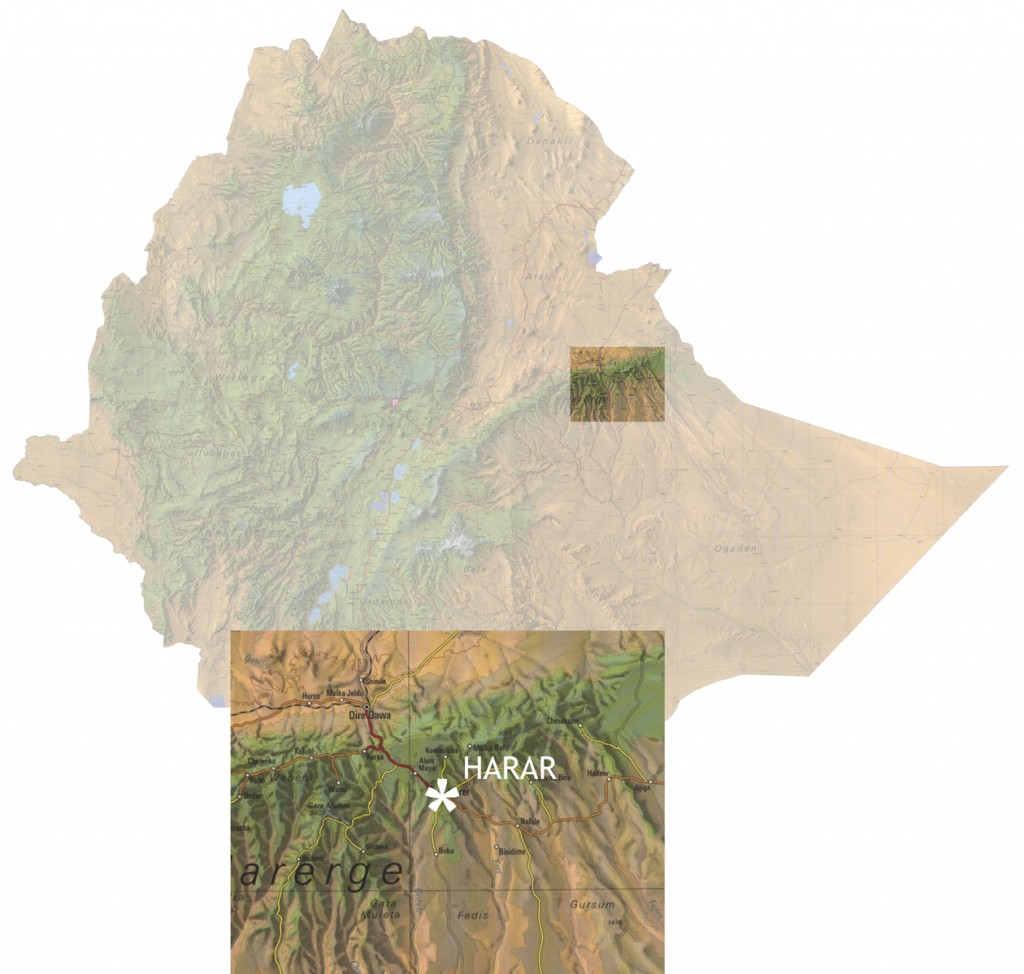The former Sultanate city of Harar in the east of Ethiopia is the religious centre for Ethiopian Muslims. For a long time Harar was a forbidden city where non-believers could not enter. It was not until 1855 when Richard Burton became the first European to enter the town in disguise. But it’s not just its spirituality which makes Harar different from other places – even the appearance and atmosphere are very different from anywhere else in Ethiopia.
A large stone wall, nearly 500 years old, surrounds the city. Five major gates provide access to the city, supplemented recently by an additional two gates. Walking through the city gates you find yourself in a maze of narrow, cobblestone alleyways, steeply rising and falling like a grid over the hill on which Harar is located. As usual in Oriental Arabic cities, the urban area is divided into a variety of neighbourhoods, each with a small local mosque. More than 80 mosques cover the city, some of them private, including a main mosque near the central square. From here starts a star-shaped plan with five main arteries leading to the five old city gates. Small dead-end roads branch off the main road, surrounded by white washed walls, leading to homes built in a unique traditional Harar style. Approximately 100 of these traditional houses still exist and are still inhabited.
A large open room marks the heart of these traditional houses. Diwanes (sitting areas) of varying heights divide the room, which is covered in carpets and where the hierarchy of the family members and guests is determined by their place in the room. The walls are densely hung with typical Harar baskets and colourful enamel bowls and trays. Directly next to the main room is the wedding niche. Following tradition, after a wedding the entrance to the wedding niche is covered and the newlyweds are left undisturbed for one week. All necessities are handed to them through a little window to the interior.
In addition, the city boasts some beautiful houses built with an Indian influence. They come from the days when Harar was the main trading hub in the region and were built by Indian merchants. It is said that the French poet Arthur Rimbaud lived in one of them in the 19th century during his stay in Harar. The renovated house is now a museum, which showcases interesting historical photographs of the city at the time around the last but one turn of the century.
Another landmark of Harar is the grave of Emir Nur, the builder of the city wall. A distinctive elliptical dome surmounts the grave from the 16th century. Roughly carved flat stones protrude like spikes from the domes surface, which is entirely painted in the holy colour of Islam – green/turquoise.
Emir Nur was the nephew and successor of the infamous Imam Grang, who took control of Harar in the 1520’s, the former capital of the Sultinate of Adal. With Harar as a base camp for decades, Grang led bloody and destructive raids against the Orthodox Christian Empire in the highlands, until he fell in 1543 in a battle near Lake Tana.
Today, however, Harar is an open, cheerful, colourful city characterized by its tolerance. A large number of small bars can be found in both the old Muslim town but also the new Christian town, which is spreading out past the gates of the old Harar. In addition, the city is home to one of Ethiopia’s largest breweries and the surrounding fertile land cultivates high-end coffee.
Another quaint tourist attraction offered in Harar, which is also known to many Ethiopians, was established around 60 years ago. After dark, so-called Hyena-Men feed wild hyenas outside the gates of the city. Currently there are two such men who feed the normally very shy predators, who eat meat directly from their hands.
..
Meals & Accommodation: The most interesting way to stay in Harar is in one of the traditional houses of the city, which can be privately rented out to tourists. Since this is a private home, no restaurant is available, however breakfast is served. In addition, there are several hotels in the city of average standards and many restaurants, cafes and bars
.
.

